Investigating the Impact of Guiding and Supporting Carers' Grieving
VerifiedAdded on 2023/01/11
|21
|8643
|23
Project
AI Summary
This project investigates the impact of guiding and supporting carers during the grieving process. It explores the influence of grieving on individuals, identifies the stages of grief following a loss (denial, anger, bargaining, depression, and acceptance), and assesses the role of carers in managing and supporting individuals through these stages. The research highlights the emotional, physical, behavioral, social, economic, religious, and metaphysical aspects of grief, emphasizing the importance of considering these factors in healthcare and family support. It also discusses the difference between acute and persistent grief, the effects of chronic stress during grief, and the need for early intervention to reduce negative health impacts. The aim of the research is to understand how guiding and supporting carers can improve the grieving process for those affected.

Project
Paraphrase This Document
Need a fresh take? Get an instant paraphrase of this document with our AI Paraphraser
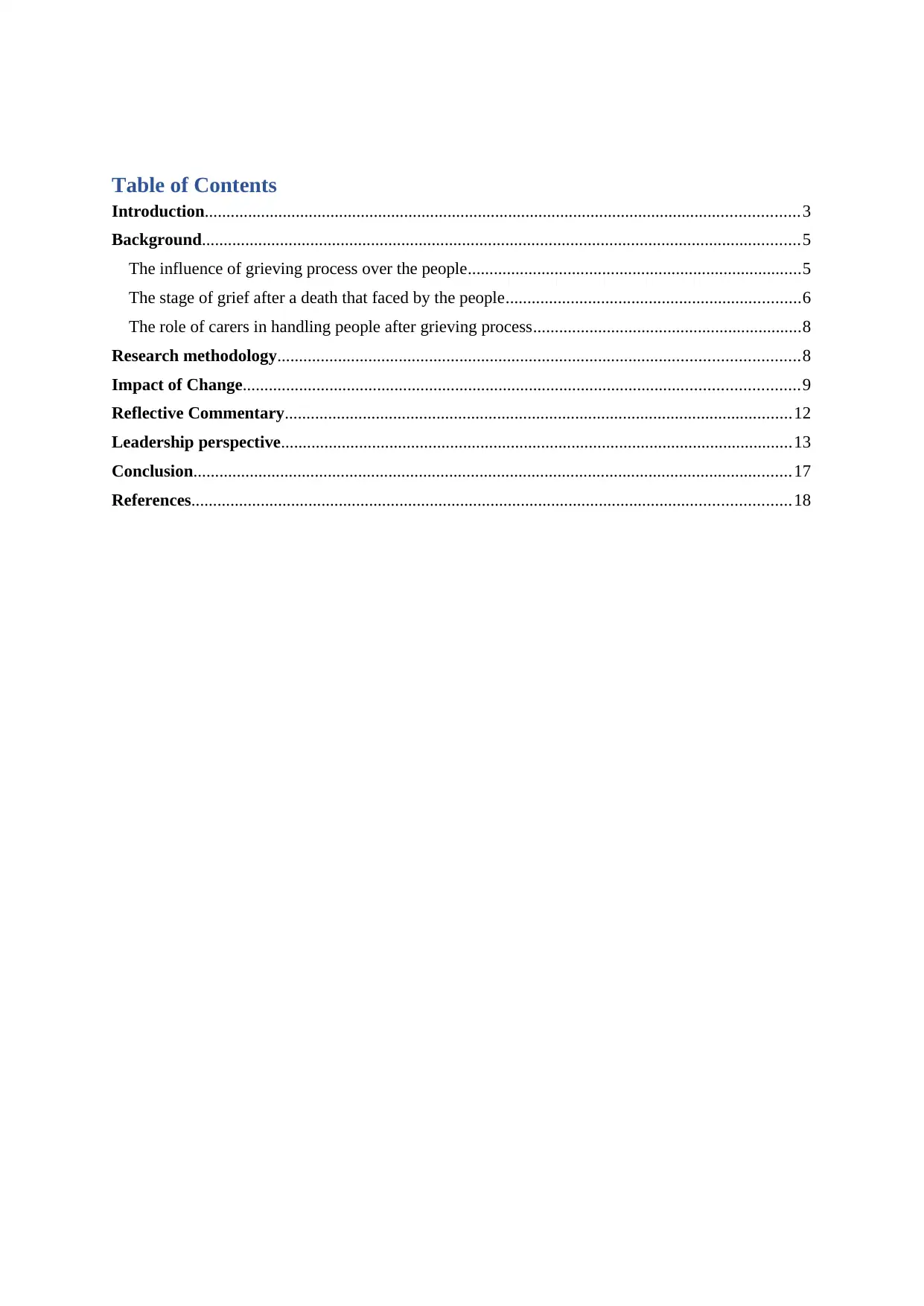
Table of Contents
Introduction.........................................................................................................................................3
Background..........................................................................................................................................5
The influence of grieving process over the people.............................................................................5
The stage of grief after a death that faced by the people....................................................................6
The role of carers in handling people after grieving process..............................................................8
Research methodology........................................................................................................................8
Impact of Change................................................................................................................................9
Reflective Commentary.....................................................................................................................12
Leadership perspective......................................................................................................................13
Conclusion..........................................................................................................................................17
References..........................................................................................................................................18
Introduction.........................................................................................................................................3
Background..........................................................................................................................................5
The influence of grieving process over the people.............................................................................5
The stage of grief after a death that faced by the people....................................................................6
The role of carers in handling people after grieving process..............................................................8
Research methodology........................................................................................................................8
Impact of Change................................................................................................................................9
Reflective Commentary.....................................................................................................................12
Leadership perspective......................................................................................................................13
Conclusion..........................................................................................................................................17
References..........................................................................................................................................18
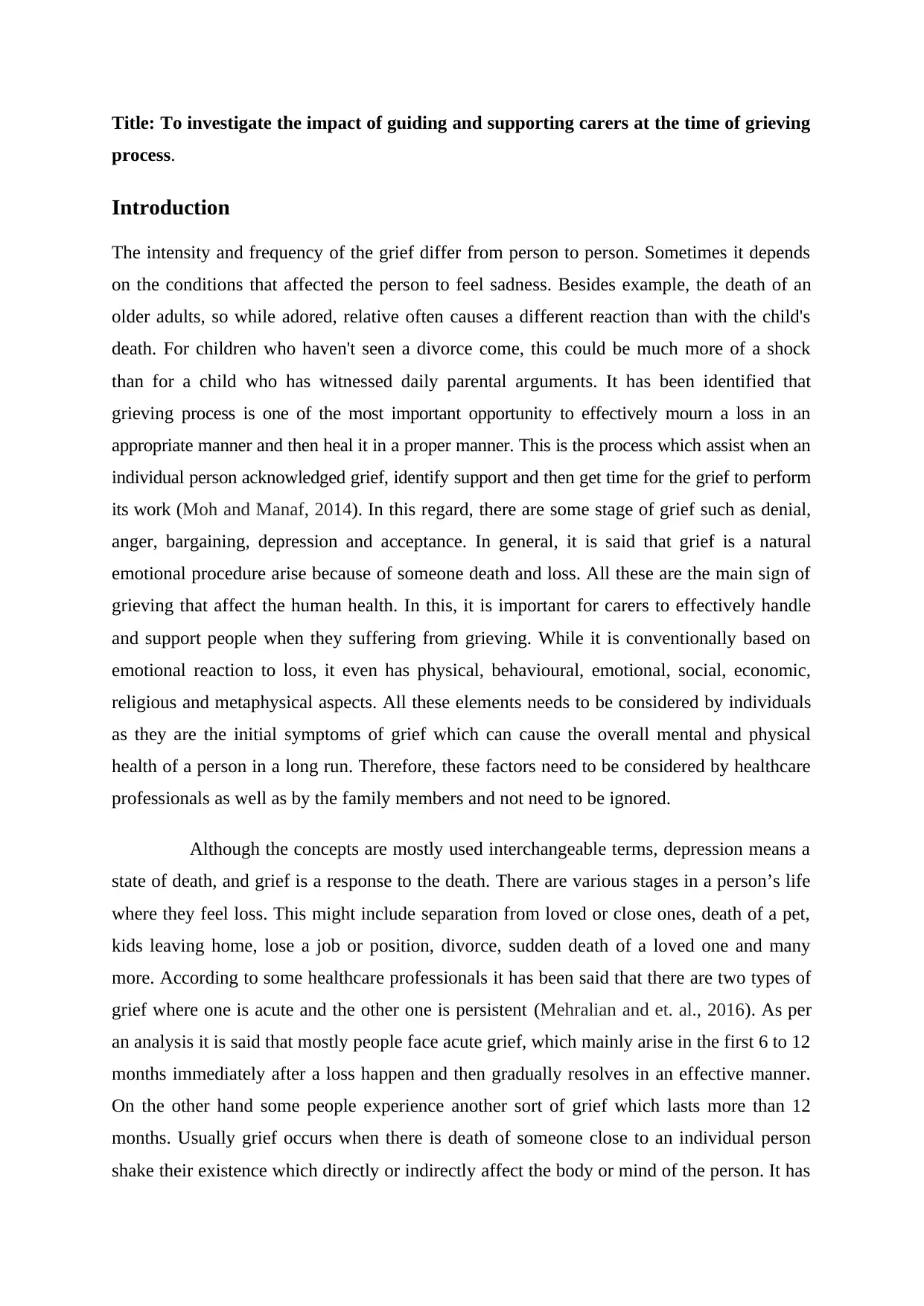
Title: To investigate the impact of guiding and supporting carers at the time of grieving
process.
Introduction
The intensity and frequency of the grief differ from person to person. Sometimes it depends
on the conditions that affected the person to feel sadness. Besides example, the death of an
older adults, so while adored, relative often causes a different reaction than with the child's
death. For children who haven't seen a divorce come, this could be much more of a shock
than for a child who has witnessed daily parental arguments. It has been identified that
grieving process is one of the most important opportunity to effectively mourn a loss in an
appropriate manner and then heal it in a proper manner. This is the process which assist when an
individual person acknowledged grief, identify support and then get time for the grief to perform
its work (Moh and Manaf, 2014). In this regard, there are some stage of grief such as denial,
anger, bargaining, depression and acceptance. In general, it is said that grief is a natural
emotional procedure arise because of someone death and loss. All these are the main sign of
grieving that affect the human health. In this, it is important for carers to effectively handle
and support people when they suffering from grieving. While it is conventionally based on
emotional reaction to loss, it even has physical, behavioural, emotional, social, economic,
religious and metaphysical aspects. All these elements needs to be considered by individuals
as they are the initial symptoms of grief which can cause the overall mental and physical
health of a person in a long run. Therefore, these factors need to be considered by healthcare
professionals as well as by the family members and not need to be ignored.
Although the concepts are mostly used interchangeable terms, depression means a
state of death, and grief is a response to the death. There are various stages in a person’s life
where they feel loss. This might include separation from loved or close ones, death of a pet,
kids leaving home, lose a job or position, divorce, sudden death of a loved one and many
more. According to some healthcare professionals it has been said that there are two types of
grief where one is acute and the other one is persistent (Mehralian and et. al., 2016). As per
an analysis it is said that mostly people face acute grief, which mainly arise in the first 6 to 12
months immediately after a loss happen and then gradually resolves in an effective manner.
On the other hand some people experience another sort of grief which lasts more than 12
months. Usually grief occurs when there is death of someone close to an individual person
shake their existence which directly or indirectly affect the body or mind of the person. It has
process.
Introduction
The intensity and frequency of the grief differ from person to person. Sometimes it depends
on the conditions that affected the person to feel sadness. Besides example, the death of an
older adults, so while adored, relative often causes a different reaction than with the child's
death. For children who haven't seen a divorce come, this could be much more of a shock
than for a child who has witnessed daily parental arguments. It has been identified that
grieving process is one of the most important opportunity to effectively mourn a loss in an
appropriate manner and then heal it in a proper manner. This is the process which assist when an
individual person acknowledged grief, identify support and then get time for the grief to perform
its work (Moh and Manaf, 2014). In this regard, there are some stage of grief such as denial,
anger, bargaining, depression and acceptance. In general, it is said that grief is a natural
emotional procedure arise because of someone death and loss. All these are the main sign of
grieving that affect the human health. In this, it is important for carers to effectively handle
and support people when they suffering from grieving. While it is conventionally based on
emotional reaction to loss, it even has physical, behavioural, emotional, social, economic,
religious and metaphysical aspects. All these elements needs to be considered by individuals
as they are the initial symptoms of grief which can cause the overall mental and physical
health of a person in a long run. Therefore, these factors need to be considered by healthcare
professionals as well as by the family members and not need to be ignored.
Although the concepts are mostly used interchangeable terms, depression means a
state of death, and grief is a response to the death. There are various stages in a person’s life
where they feel loss. This might include separation from loved or close ones, death of a pet,
kids leaving home, lose a job or position, divorce, sudden death of a loved one and many
more. According to some healthcare professionals it has been said that there are two types of
grief where one is acute and the other one is persistent (Mehralian and et. al., 2016). As per
an analysis it is said that mostly people face acute grief, which mainly arise in the first 6 to 12
months immediately after a loss happen and then gradually resolves in an effective manner.
On the other hand some people experience another sort of grief which lasts more than 12
months. Usually grief occurs when there is death of someone close to an individual person
shake their existence which directly or indirectly affect the body or mind of the person. It has
⊘ This is a preview!⊘
Do you want full access?
Subscribe today to unlock all pages.

Trusted by 1+ million students worldwide
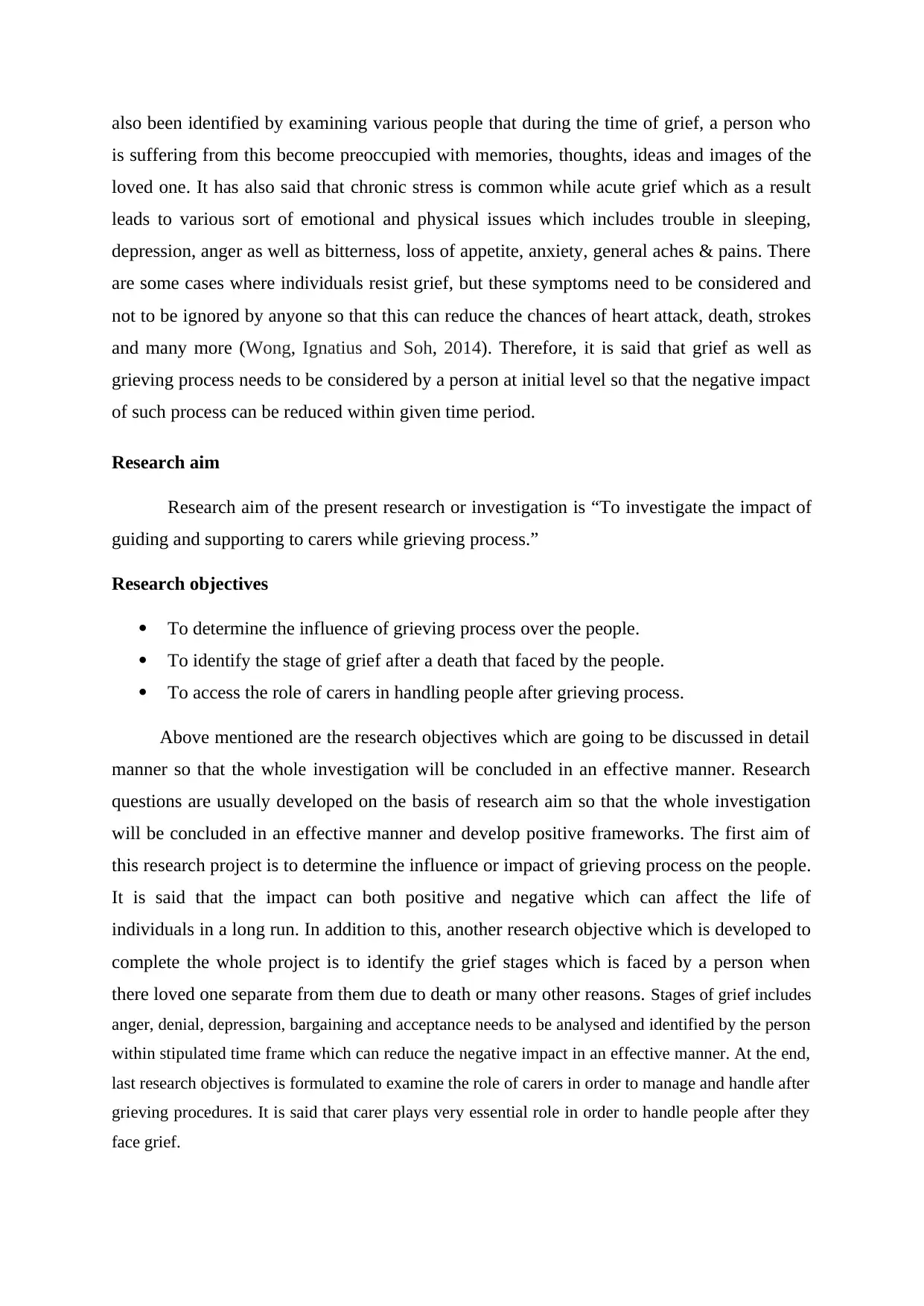
also been identified by examining various people that during the time of grief, a person who
is suffering from this become preoccupied with memories, thoughts, ideas and images of the
loved one. It has also said that chronic stress is common while acute grief which as a result
leads to various sort of emotional and physical issues which includes trouble in sleeping,
depression, anger as well as bitterness, loss of appetite, anxiety, general aches & pains. There
are some cases where individuals resist grief, but these symptoms need to be considered and
not to be ignored by anyone so that this can reduce the chances of heart attack, death, strokes
and many more (Wong, Ignatius and Soh, 2014). Therefore, it is said that grief as well as
grieving process needs to be considered by a person at initial level so that the negative impact
of such process can be reduced within given time period.
Research aim
Research aim of the present research or investigation is “To investigate the impact of
guiding and supporting to carers while grieving process.”
Research objectives
To determine the influence of grieving process over the people.
To identify the stage of grief after a death that faced by the people.
To access the role of carers in handling people after grieving process.
Above mentioned are the research objectives which are going to be discussed in detail
manner so that the whole investigation will be concluded in an effective manner. Research
questions are usually developed on the basis of research aim so that the whole investigation
will be concluded in an effective manner and develop positive frameworks. The first aim of
this research project is to determine the influence or impact of grieving process on the people.
It is said that the impact can both positive and negative which can affect the life of
individuals in a long run. In addition to this, another research objective which is developed to
complete the whole project is to identify the grief stages which is faced by a person when
there loved one separate from them due to death or many other reasons. Stages of grief includes
anger, denial, depression, bargaining and acceptance needs to be analysed and identified by the person
within stipulated time frame which can reduce the negative impact in an effective manner. At the end,
last research objectives is formulated to examine the role of carers in order to manage and handle after
grieving procedures. It is said that carer plays very essential role in order to handle people after they
face grief.
is suffering from this become preoccupied with memories, thoughts, ideas and images of the
loved one. It has also said that chronic stress is common while acute grief which as a result
leads to various sort of emotional and physical issues which includes trouble in sleeping,
depression, anger as well as bitterness, loss of appetite, anxiety, general aches & pains. There
are some cases where individuals resist grief, but these symptoms need to be considered and
not to be ignored by anyone so that this can reduce the chances of heart attack, death, strokes
and many more (Wong, Ignatius and Soh, 2014). Therefore, it is said that grief as well as
grieving process needs to be considered by a person at initial level so that the negative impact
of such process can be reduced within given time period.
Research aim
Research aim of the present research or investigation is “To investigate the impact of
guiding and supporting to carers while grieving process.”
Research objectives
To determine the influence of grieving process over the people.
To identify the stage of grief after a death that faced by the people.
To access the role of carers in handling people after grieving process.
Above mentioned are the research objectives which are going to be discussed in detail
manner so that the whole investigation will be concluded in an effective manner. Research
questions are usually developed on the basis of research aim so that the whole investigation
will be concluded in an effective manner and develop positive frameworks. The first aim of
this research project is to determine the influence or impact of grieving process on the people.
It is said that the impact can both positive and negative which can affect the life of
individuals in a long run. In addition to this, another research objective which is developed to
complete the whole project is to identify the grief stages which is faced by a person when
there loved one separate from them due to death or many other reasons. Stages of grief includes
anger, denial, depression, bargaining and acceptance needs to be analysed and identified by the person
within stipulated time frame which can reduce the negative impact in an effective manner. At the end,
last research objectives is formulated to examine the role of carers in order to manage and handle after
grieving procedures. It is said that carer plays very essential role in order to handle people after they
face grief.
Paraphrase This Document
Need a fresh take? Get an instant paraphrase of this document with our AI Paraphraser
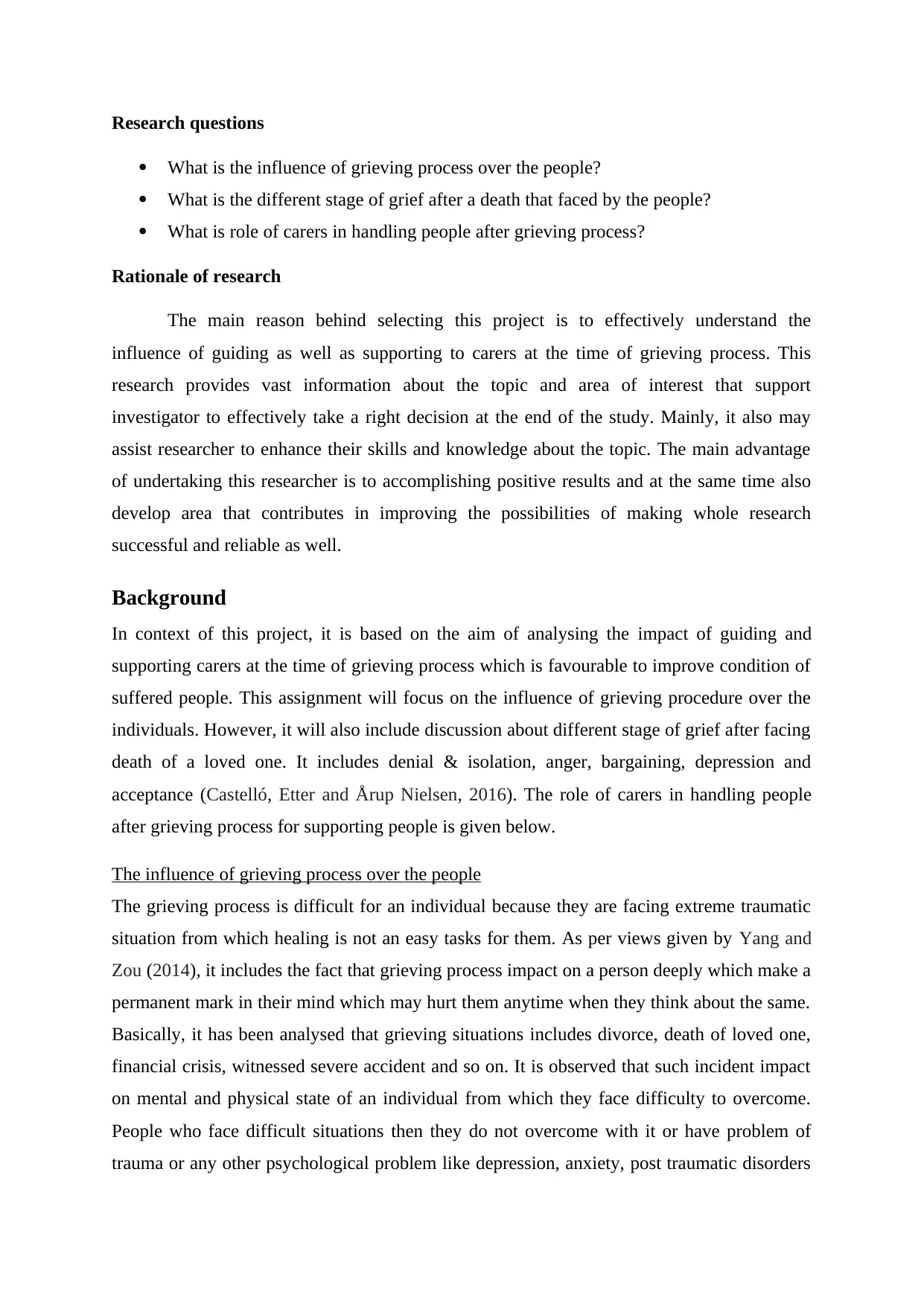
Research questions
What is the influence of grieving process over the people?
What is the different stage of grief after a death that faced by the people?
What is role of carers in handling people after grieving process?
Rationale of research
The main reason behind selecting this project is to effectively understand the
influence of guiding as well as supporting to carers at the time of grieving process. This
research provides vast information about the topic and area of interest that support
investigator to effectively take a right decision at the end of the study. Mainly, it also may
assist researcher to enhance their skills and knowledge about the topic. The main advantage
of undertaking this researcher is to accomplishing positive results and at the same time also
develop area that contributes in improving the possibilities of making whole research
successful and reliable as well.
Background
In context of this project, it is based on the aim of analysing the impact of guiding and
supporting carers at the time of grieving process which is favourable to improve condition of
suffered people. This assignment will focus on the influence of grieving procedure over the
individuals. However, it will also include discussion about different stage of grief after facing
death of a loved one. It includes denial & isolation, anger, bargaining, depression and
acceptance (Castelló, Etter and Årup Nielsen, 2016). The role of carers in handling people
after grieving process for supporting people is given below.
The influence of grieving process over the people
The grieving process is difficult for an individual because they are facing extreme traumatic
situation from which healing is not an easy tasks for them. As per views given by Yang and
Zou (2014), it includes the fact that grieving process impact on a person deeply which make a
permanent mark in their mind which may hurt them anytime when they think about the same.
Basically, it has been analysed that grieving situations includes divorce, death of loved one,
financial crisis, witnessed severe accident and so on. It is observed that such incident impact
on mental and physical state of an individual from which they face difficulty to overcome.
People who face difficult situations then they do not overcome with it or have problem of
trauma or any other psychological problem like depression, anxiety, post traumatic disorders
What is the influence of grieving process over the people?
What is the different stage of grief after a death that faced by the people?
What is role of carers in handling people after grieving process?
Rationale of research
The main reason behind selecting this project is to effectively understand the
influence of guiding as well as supporting to carers at the time of grieving process. This
research provides vast information about the topic and area of interest that support
investigator to effectively take a right decision at the end of the study. Mainly, it also may
assist researcher to enhance their skills and knowledge about the topic. The main advantage
of undertaking this researcher is to accomplishing positive results and at the same time also
develop area that contributes in improving the possibilities of making whole research
successful and reliable as well.
Background
In context of this project, it is based on the aim of analysing the impact of guiding and
supporting carers at the time of grieving process which is favourable to improve condition of
suffered people. This assignment will focus on the influence of grieving procedure over the
individuals. However, it will also include discussion about different stage of grief after facing
death of a loved one. It includes denial & isolation, anger, bargaining, depression and
acceptance (Castelló, Etter and Årup Nielsen, 2016). The role of carers in handling people
after grieving process for supporting people is given below.
The influence of grieving process over the people
The grieving process is difficult for an individual because they are facing extreme traumatic
situation from which healing is not an easy tasks for them. As per views given by Yang and
Zou (2014), it includes the fact that grieving process impact on a person deeply which make a
permanent mark in their mind which may hurt them anytime when they think about the same.
Basically, it has been analysed that grieving situations includes divorce, death of loved one,
financial crisis, witnessed severe accident and so on. It is observed that such incident impact
on mental and physical state of an individual from which they face difficulty to overcome.
People who face difficult situations then they do not overcome with it or have problem of
trauma or any other psychological problem like depression, anxiety, post traumatic disorders
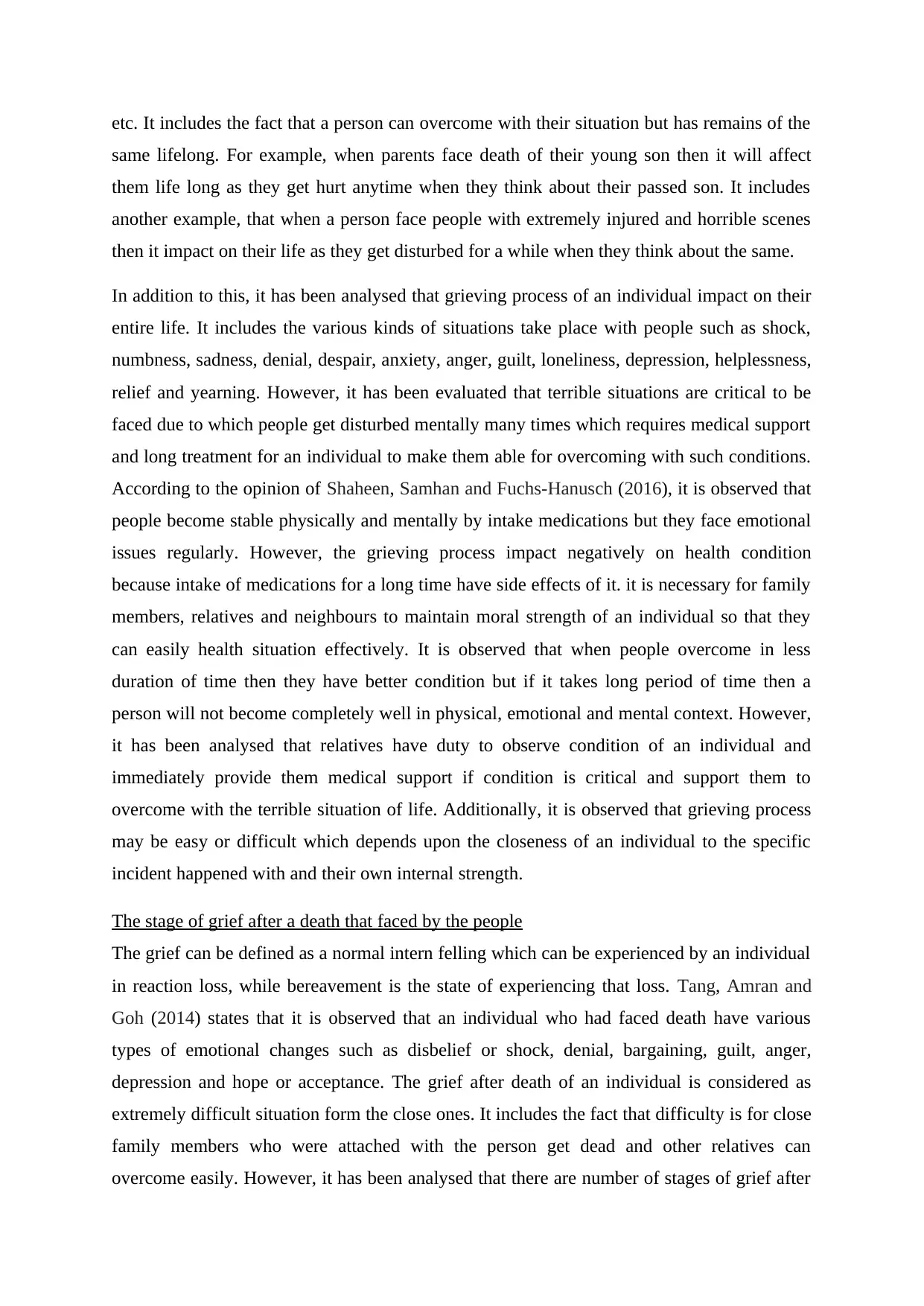
etc. It includes the fact that a person can overcome with their situation but has remains of the
same lifelong. For example, when parents face death of their young son then it will affect
them life long as they get hurt anytime when they think about their passed son. It includes
another example, that when a person face people with extremely injured and horrible scenes
then it impact on their life as they get disturbed for a while when they think about the same.
In addition to this, it has been analysed that grieving process of an individual impact on their
entire life. It includes the various kinds of situations take place with people such as shock,
numbness, sadness, denial, despair, anxiety, anger, guilt, loneliness, depression, helplessness,
relief and yearning. However, it has been evaluated that terrible situations are critical to be
faced due to which people get disturbed mentally many times which requires medical support
and long treatment for an individual to make them able for overcoming with such conditions.
According to the opinion of Shaheen, Samhan and Fuchs-Hanusch (2016), it is observed that
people become stable physically and mentally by intake medications but they face emotional
issues regularly. However, the grieving process impact negatively on health condition
because intake of medications for a long time have side effects of it. it is necessary for family
members, relatives and neighbours to maintain moral strength of an individual so that they
can easily health situation effectively. It is observed that when people overcome in less
duration of time then they have better condition but if it takes long period of time then a
person will not become completely well in physical, emotional and mental context. However,
it has been analysed that relatives have duty to observe condition of an individual and
immediately provide them medical support if condition is critical and support them to
overcome with the terrible situation of life. Additionally, it is observed that grieving process
may be easy or difficult which depends upon the closeness of an individual to the specific
incident happened with and their own internal strength.
The stage of grief after a death that faced by the people
The grief can be defined as a normal intern felling which can be experienced by an individual
in reaction loss, while bereavement is the state of experiencing that loss. Tang, Amran and
Goh (2014) states that it is observed that an individual who had faced death have various
types of emotional changes such as disbelief or shock, denial, bargaining, guilt, anger,
depression and hope or acceptance. The grief after death of an individual is considered as
extremely difficult situation form the close ones. It includes the fact that difficulty is for close
family members who were attached with the person get dead and other relatives can
overcome easily. However, it has been analysed that there are number of stages of grief after
same lifelong. For example, when parents face death of their young son then it will affect
them life long as they get hurt anytime when they think about their passed son. It includes
another example, that when a person face people with extremely injured and horrible scenes
then it impact on their life as they get disturbed for a while when they think about the same.
In addition to this, it has been analysed that grieving process of an individual impact on their
entire life. It includes the various kinds of situations take place with people such as shock,
numbness, sadness, denial, despair, anxiety, anger, guilt, loneliness, depression, helplessness,
relief and yearning. However, it has been evaluated that terrible situations are critical to be
faced due to which people get disturbed mentally many times which requires medical support
and long treatment for an individual to make them able for overcoming with such conditions.
According to the opinion of Shaheen, Samhan and Fuchs-Hanusch (2016), it is observed that
people become stable physically and mentally by intake medications but they face emotional
issues regularly. However, the grieving process impact negatively on health condition
because intake of medications for a long time have side effects of it. it is necessary for family
members, relatives and neighbours to maintain moral strength of an individual so that they
can easily health situation effectively. It is observed that when people overcome in less
duration of time then they have better condition but if it takes long period of time then a
person will not become completely well in physical, emotional and mental context. However,
it has been analysed that relatives have duty to observe condition of an individual and
immediately provide them medical support if condition is critical and support them to
overcome with the terrible situation of life. Additionally, it is observed that grieving process
may be easy or difficult which depends upon the closeness of an individual to the specific
incident happened with and their own internal strength.
The stage of grief after a death that faced by the people
The grief can be defined as a normal intern felling which can be experienced by an individual
in reaction loss, while bereavement is the state of experiencing that loss. Tang, Amran and
Goh (2014) states that it is observed that an individual who had faced death have various
types of emotional changes such as disbelief or shock, denial, bargaining, guilt, anger,
depression and hope or acceptance. The grief after death of an individual is considered as
extremely difficult situation form the close ones. It includes the fact that difficulty is for close
family members who were attached with the person get dead and other relatives can
overcome easily. However, it has been analysed that there are number of stages of grief after
⊘ This is a preview!⊘
Do you want full access?
Subscribe today to unlock all pages.

Trusted by 1+ million students worldwide
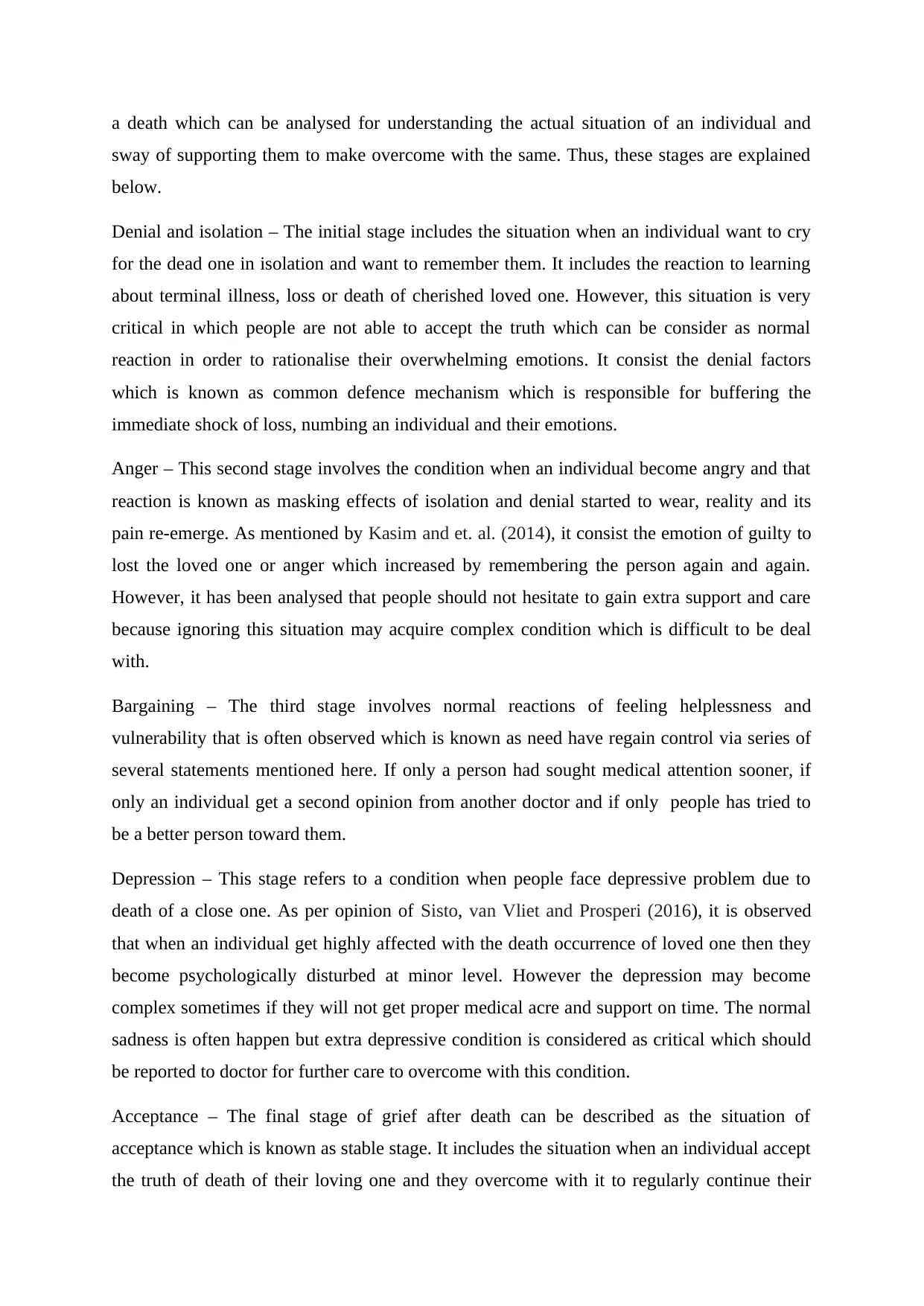
a death which can be analysed for understanding the actual situation of an individual and
sway of supporting them to make overcome with the same. Thus, these stages are explained
below.
Denial and isolation – The initial stage includes the situation when an individual want to cry
for the dead one in isolation and want to remember them. It includes the reaction to learning
about terminal illness, loss or death of cherished loved one. However, this situation is very
critical in which people are not able to accept the truth which can be consider as normal
reaction in order to rationalise their overwhelming emotions. It consist the denial factors
which is known as common defence mechanism which is responsible for buffering the
immediate shock of loss, numbing an individual and their emotions.
Anger – This second stage involves the condition when an individual become angry and that
reaction is known as masking effects of isolation and denial started to wear, reality and its
pain re-emerge. As mentioned by Kasim and et. al. (2014), it consist the emotion of guilty to
lost the loved one or anger which increased by remembering the person again and again.
However, it has been analysed that people should not hesitate to gain extra support and care
because ignoring this situation may acquire complex condition which is difficult to be deal
with.
Bargaining – The third stage involves normal reactions of feeling helplessness and
vulnerability that is often observed which is known as need have regain control via series of
several statements mentioned here. If only a person had sought medical attention sooner, if
only an individual get a second opinion from another doctor and if only people has tried to
be a better person toward them.
Depression – This stage refers to a condition when people face depressive problem due to
death of a close one. As per opinion of Sisto, van Vliet and Prosperi (2016), it is observed
that when an individual get highly affected with the death occurrence of loved one then they
become psychologically disturbed at minor level. However the depression may become
complex sometimes if they will not get proper medical acre and support on time. The normal
sadness is often happen but extra depressive condition is considered as critical which should
be reported to doctor for further care to overcome with this condition.
Acceptance – The final stage of grief after death can be described as the situation of
acceptance which is known as stable stage. It includes the situation when an individual accept
the truth of death of their loving one and they overcome with it to regularly continue their
sway of supporting them to make overcome with the same. Thus, these stages are explained
below.
Denial and isolation – The initial stage includes the situation when an individual want to cry
for the dead one in isolation and want to remember them. It includes the reaction to learning
about terminal illness, loss or death of cherished loved one. However, this situation is very
critical in which people are not able to accept the truth which can be consider as normal
reaction in order to rationalise their overwhelming emotions. It consist the denial factors
which is known as common defence mechanism which is responsible for buffering the
immediate shock of loss, numbing an individual and their emotions.
Anger – This second stage involves the condition when an individual become angry and that
reaction is known as masking effects of isolation and denial started to wear, reality and its
pain re-emerge. As mentioned by Kasim and et. al. (2014), it consist the emotion of guilty to
lost the loved one or anger which increased by remembering the person again and again.
However, it has been analysed that people should not hesitate to gain extra support and care
because ignoring this situation may acquire complex condition which is difficult to be deal
with.
Bargaining – The third stage involves normal reactions of feeling helplessness and
vulnerability that is often observed which is known as need have regain control via series of
several statements mentioned here. If only a person had sought medical attention sooner, if
only an individual get a second opinion from another doctor and if only people has tried to
be a better person toward them.
Depression – This stage refers to a condition when people face depressive problem due to
death of a close one. As per opinion of Sisto, van Vliet and Prosperi (2016), it is observed
that when an individual get highly affected with the death occurrence of loved one then they
become psychologically disturbed at minor level. However the depression may become
complex sometimes if they will not get proper medical acre and support on time. The normal
sadness is often happen but extra depressive condition is considered as critical which should
be reported to doctor for further care to overcome with this condition.
Acceptance – The final stage of grief after death can be described as the situation of
acceptance which is known as stable stage. It includes the situation when an individual accept
the truth of death of their loving one and they overcome with it to regularly continue their
Paraphrase This Document
Need a fresh take? Get an instant paraphrase of this document with our AI Paraphraser
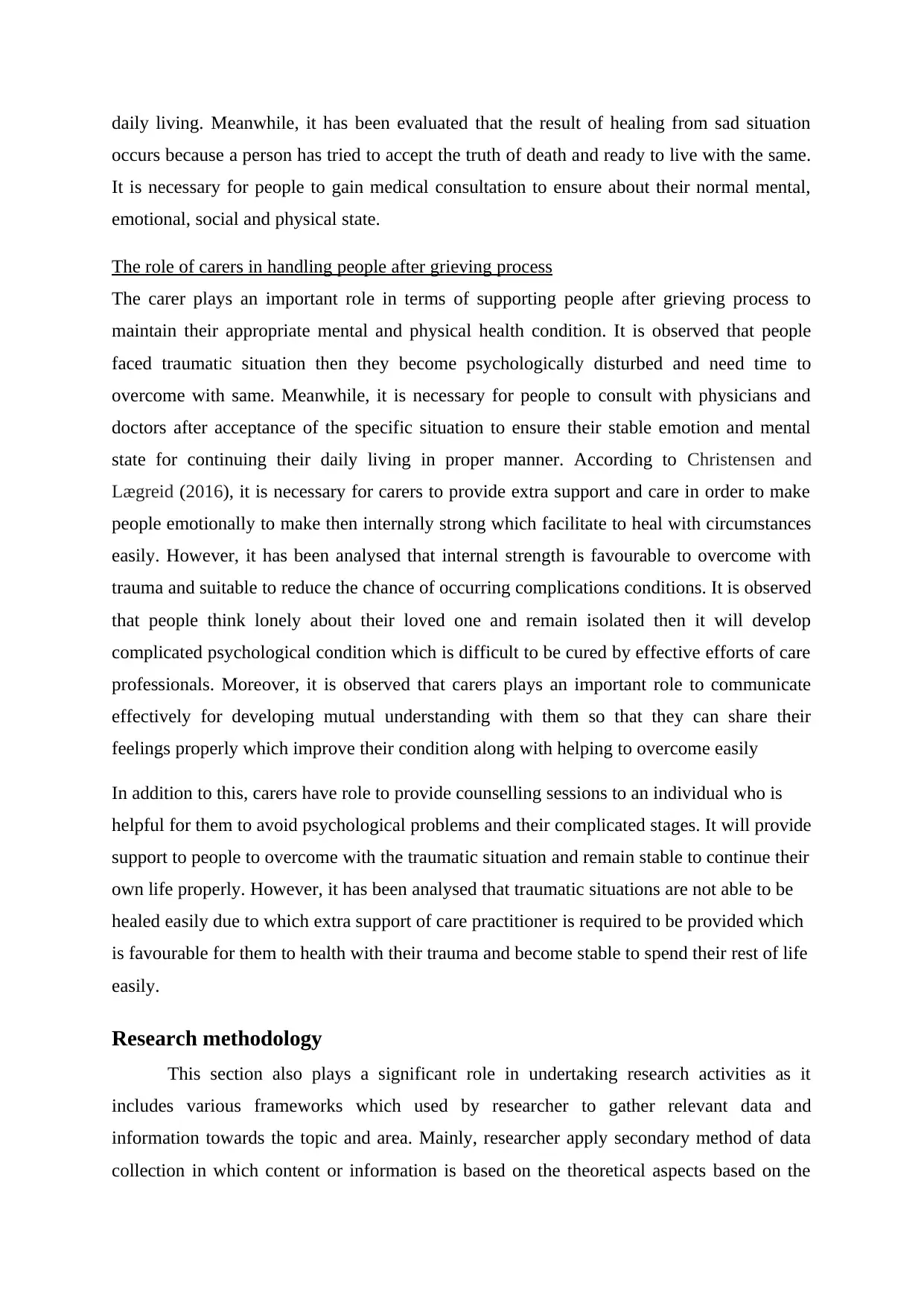
daily living. Meanwhile, it has been evaluated that the result of healing from sad situation
occurs because a person has tried to accept the truth of death and ready to live with the same.
It is necessary for people to gain medical consultation to ensure about their normal mental,
emotional, social and physical state.
The role of carers in handling people after grieving process
The carer plays an important role in terms of supporting people after grieving process to
maintain their appropriate mental and physical health condition. It is observed that people
faced traumatic situation then they become psychologically disturbed and need time to
overcome with same. Meanwhile, it is necessary for people to consult with physicians and
doctors after acceptance of the specific situation to ensure their stable emotion and mental
state for continuing their daily living in proper manner. According to Christensen and
Lægreid (2016), it is necessary for carers to provide extra support and care in order to make
people emotionally to make then internally strong which facilitate to heal with circumstances
easily. However, it has been analysed that internal strength is favourable to overcome with
trauma and suitable to reduce the chance of occurring complications conditions. It is observed
that people think lonely about their loved one and remain isolated then it will develop
complicated psychological condition which is difficult to be cured by effective efforts of care
professionals. Moreover, it is observed that carers plays an important role to communicate
effectively for developing mutual understanding with them so that they can share their
feelings properly which improve their condition along with helping to overcome easily
In addition to this, carers have role to provide counselling sessions to an individual who is
helpful for them to avoid psychological problems and their complicated stages. It will provide
support to people to overcome with the traumatic situation and remain stable to continue their
own life properly. However, it has been analysed that traumatic situations are not able to be
healed easily due to which extra support of care practitioner is required to be provided which
is favourable for them to health with their trauma and become stable to spend their rest of life
easily.
Research methodology
This section also plays a significant role in undertaking research activities as it
includes various frameworks which used by researcher to gather relevant data and
information towards the topic and area. Mainly, researcher apply secondary method of data
collection in which content or information is based on the theoretical aspects based on the
occurs because a person has tried to accept the truth of death and ready to live with the same.
It is necessary for people to gain medical consultation to ensure about their normal mental,
emotional, social and physical state.
The role of carers in handling people after grieving process
The carer plays an important role in terms of supporting people after grieving process to
maintain their appropriate mental and physical health condition. It is observed that people
faced traumatic situation then they become psychologically disturbed and need time to
overcome with same. Meanwhile, it is necessary for people to consult with physicians and
doctors after acceptance of the specific situation to ensure their stable emotion and mental
state for continuing their daily living in proper manner. According to Christensen and
Lægreid (2016), it is necessary for carers to provide extra support and care in order to make
people emotionally to make then internally strong which facilitate to heal with circumstances
easily. However, it has been analysed that internal strength is favourable to overcome with
trauma and suitable to reduce the chance of occurring complications conditions. It is observed
that people think lonely about their loved one and remain isolated then it will develop
complicated psychological condition which is difficult to be cured by effective efforts of care
professionals. Moreover, it is observed that carers plays an important role to communicate
effectively for developing mutual understanding with them so that they can share their
feelings properly which improve their condition along with helping to overcome easily
In addition to this, carers have role to provide counselling sessions to an individual who is
helpful for them to avoid psychological problems and their complicated stages. It will provide
support to people to overcome with the traumatic situation and remain stable to continue their
own life properly. However, it has been analysed that traumatic situations are not able to be
healed easily due to which extra support of care practitioner is required to be provided which
is favourable for them to health with their trauma and become stable to spend their rest of life
easily.
Research methodology
This section also plays a significant role in undertaking research activities as it
includes various frameworks which used by researcher to gather relevant data and
information towards the topic and area. Mainly, researcher apply secondary method of data
collection in which content or information is based on the theoretical aspects based on the
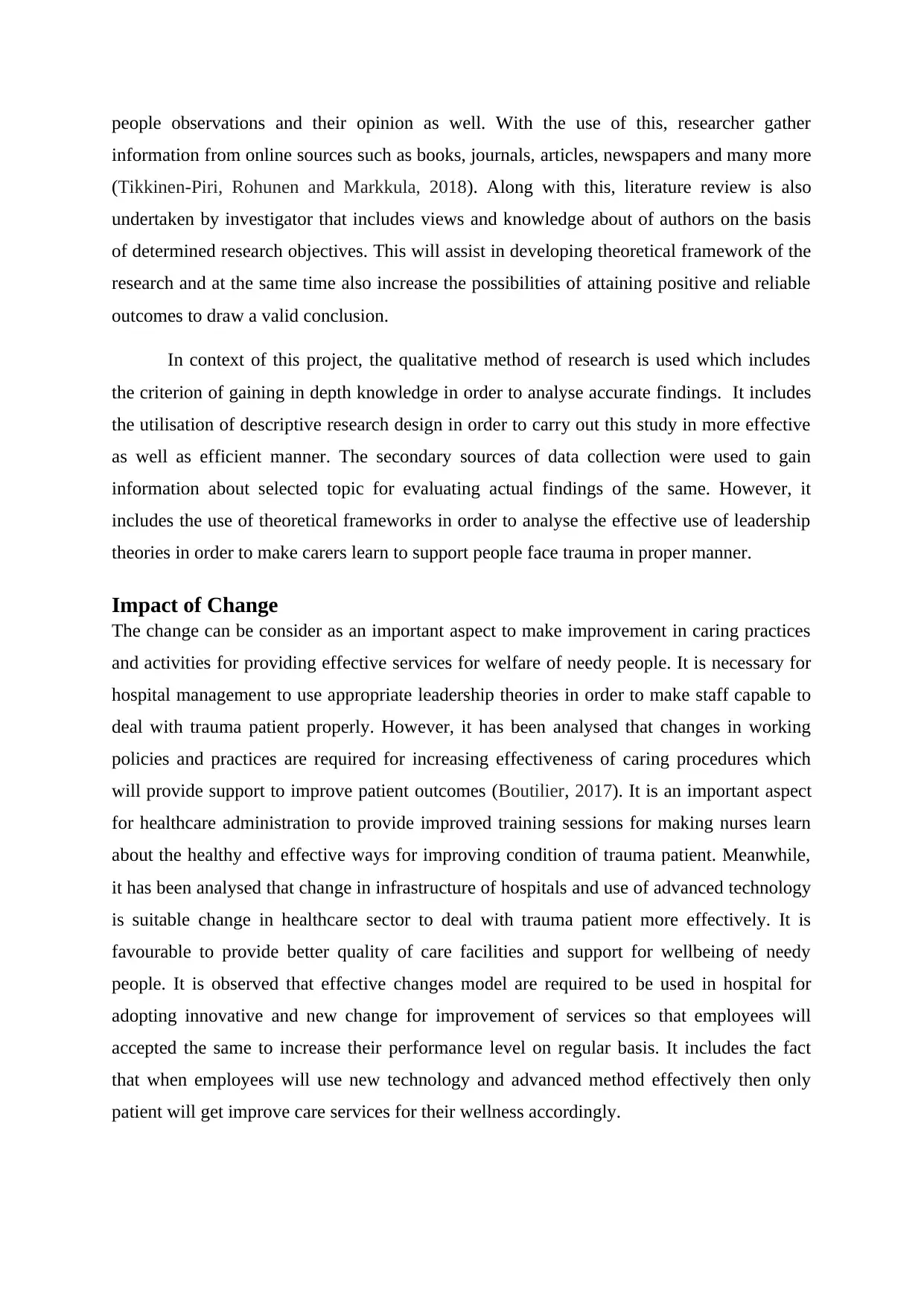
people observations and their opinion as well. With the use of this, researcher gather
information from online sources such as books, journals, articles, newspapers and many more
(Tikkinen-Piri, Rohunen and Markkula, 2018). Along with this, literature review is also
undertaken by investigator that includes views and knowledge about of authors on the basis
of determined research objectives. This will assist in developing theoretical framework of the
research and at the same time also increase the possibilities of attaining positive and reliable
outcomes to draw a valid conclusion.
In context of this project, the qualitative method of research is used which includes
the criterion of gaining in depth knowledge in order to analyse accurate findings. It includes
the utilisation of descriptive research design in order to carry out this study in more effective
as well as efficient manner. The secondary sources of data collection were used to gain
information about selected topic for evaluating actual findings of the same. However, it
includes the use of theoretical frameworks in order to analyse the effective use of leadership
theories in order to make carers learn to support people face trauma in proper manner.
Impact of Change
The change can be consider as an important aspect to make improvement in caring practices
and activities for providing effective services for welfare of needy people. It is necessary for
hospital management to use appropriate leadership theories in order to make staff capable to
deal with trauma patient properly. However, it has been analysed that changes in working
policies and practices are required for increasing effectiveness of caring procedures which
will provide support to improve patient outcomes (Boutilier, 2017). It is an important aspect
for healthcare administration to provide improved training sessions for making nurses learn
about the healthy and effective ways for improving condition of trauma patient. Meanwhile,
it has been analysed that change in infrastructure of hospitals and use of advanced technology
is suitable change in healthcare sector to deal with trauma patient more effectively. It is
favourable to provide better quality of care facilities and support for wellbeing of needy
people. It is observed that effective changes model are required to be used in hospital for
adopting innovative and new change for improvement of services so that employees will
accepted the same to increase their performance level on regular basis. It includes the fact
that when employees will use new technology and advanced method effectively then only
patient will get improve care services for their wellness accordingly.
information from online sources such as books, journals, articles, newspapers and many more
(Tikkinen-Piri, Rohunen and Markkula, 2018). Along with this, literature review is also
undertaken by investigator that includes views and knowledge about of authors on the basis
of determined research objectives. This will assist in developing theoretical framework of the
research and at the same time also increase the possibilities of attaining positive and reliable
outcomes to draw a valid conclusion.
In context of this project, the qualitative method of research is used which includes
the criterion of gaining in depth knowledge in order to analyse accurate findings. It includes
the utilisation of descriptive research design in order to carry out this study in more effective
as well as efficient manner. The secondary sources of data collection were used to gain
information about selected topic for evaluating actual findings of the same. However, it
includes the use of theoretical frameworks in order to analyse the effective use of leadership
theories in order to make carers learn to support people face trauma in proper manner.
Impact of Change
The change can be consider as an important aspect to make improvement in caring practices
and activities for providing effective services for welfare of needy people. It is necessary for
hospital management to use appropriate leadership theories in order to make staff capable to
deal with trauma patient properly. However, it has been analysed that changes in working
policies and practices are required for increasing effectiveness of caring procedures which
will provide support to improve patient outcomes (Boutilier, 2017). It is an important aspect
for healthcare administration to provide improved training sessions for making nurses learn
about the healthy and effective ways for improving condition of trauma patient. Meanwhile,
it has been analysed that change in infrastructure of hospitals and use of advanced technology
is suitable change in healthcare sector to deal with trauma patient more effectively. It is
favourable to provide better quality of care facilities and support for wellbeing of needy
people. It is observed that effective changes model are required to be used in hospital for
adopting innovative and new change for improvement of services so that employees will
accepted the same to increase their performance level on regular basis. It includes the fact
that when employees will use new technology and advanced method effectively then only
patient will get improve care services for their wellness accordingly.
⊘ This is a preview!⊘
Do you want full access?
Subscribe today to unlock all pages.

Trusted by 1+ million students worldwide
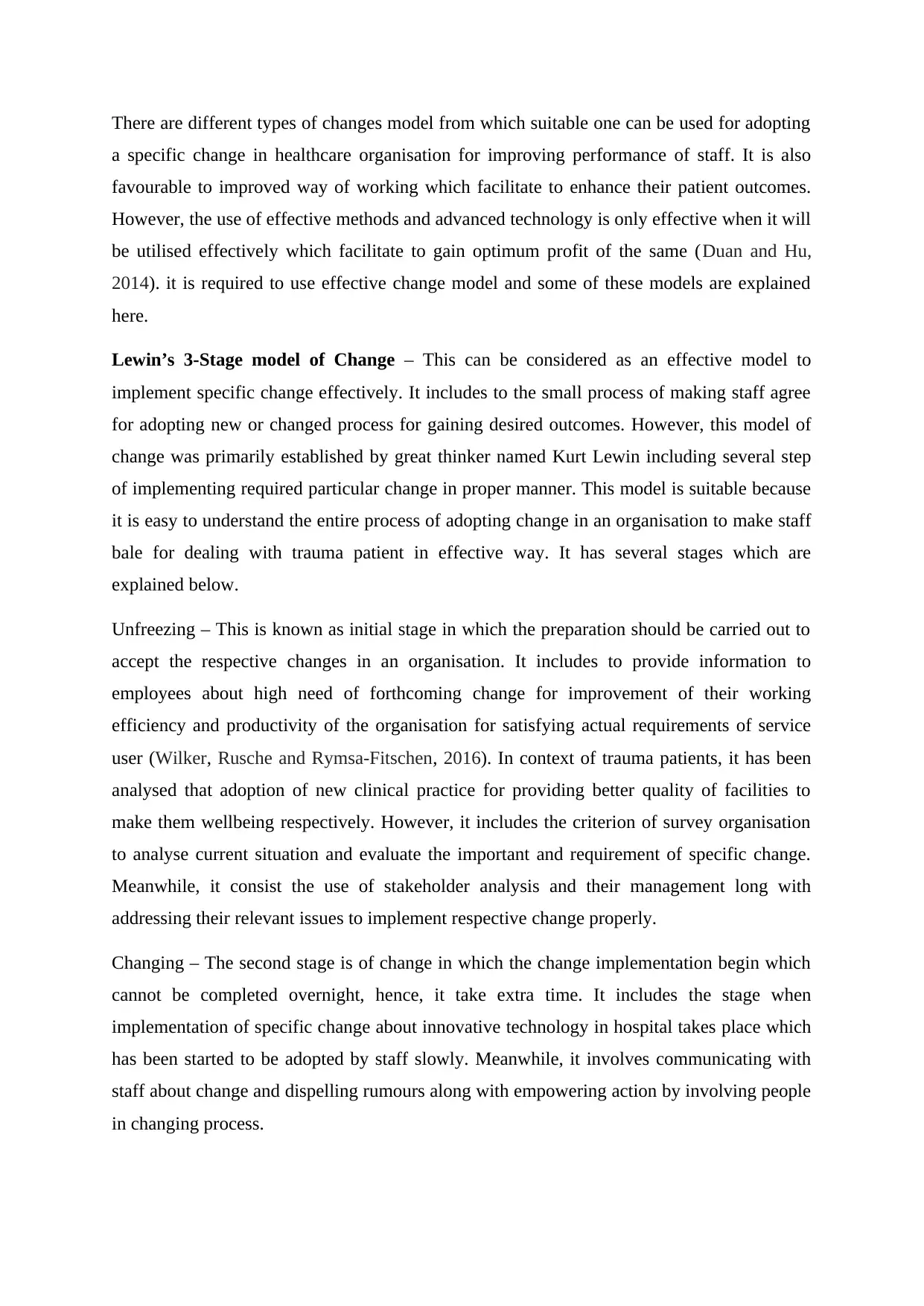
There are different types of changes model from which suitable one can be used for adopting
a specific change in healthcare organisation for improving performance of staff. It is also
favourable to improved way of working which facilitate to enhance their patient outcomes.
However, the use of effective methods and advanced technology is only effective when it will
be utilised effectively which facilitate to gain optimum profit of the same (Duan and Hu,
2014). it is required to use effective change model and some of these models are explained
here.
Lewin’s 3-Stage model of Change – This can be considered as an effective model to
implement specific change effectively. It includes to the small process of making staff agree
for adopting new or changed process for gaining desired outcomes. However, this model of
change was primarily established by great thinker named Kurt Lewin including several step
of implementing required particular change in proper manner. This model is suitable because
it is easy to understand the entire process of adopting change in an organisation to make staff
bale for dealing with trauma patient in effective way. It has several stages which are
explained below.
Unfreezing – This is known as initial stage in which the preparation should be carried out to
accept the respective changes in an organisation. It includes to provide information to
employees about high need of forthcoming change for improvement of their working
efficiency and productivity of the organisation for satisfying actual requirements of service
user (Wilker, Rusche and Rymsa-Fitschen, 2016). In context of trauma patients, it has been
analysed that adoption of new clinical practice for providing better quality of facilities to
make them wellbeing respectively. However, it includes the criterion of survey organisation
to analyse current situation and evaluate the important and requirement of specific change.
Meanwhile, it consist the use of stakeholder analysis and their management long with
addressing their relevant issues to implement respective change properly.
Changing – The second stage is of change in which the change implementation begin which
cannot be completed overnight, hence, it take extra time. It includes the stage when
implementation of specific change about innovative technology in hospital takes place which
has been started to be adopted by staff slowly. Meanwhile, it involves communicating with
staff about change and dispelling rumours along with empowering action by involving people
in changing process.
a specific change in healthcare organisation for improving performance of staff. It is also
favourable to improved way of working which facilitate to enhance their patient outcomes.
However, the use of effective methods and advanced technology is only effective when it will
be utilised effectively which facilitate to gain optimum profit of the same (Duan and Hu,
2014). it is required to use effective change model and some of these models are explained
here.
Lewin’s 3-Stage model of Change – This can be considered as an effective model to
implement specific change effectively. It includes to the small process of making staff agree
for adopting new or changed process for gaining desired outcomes. However, this model of
change was primarily established by great thinker named Kurt Lewin including several step
of implementing required particular change in proper manner. This model is suitable because
it is easy to understand the entire process of adopting change in an organisation to make staff
bale for dealing with trauma patient in effective way. It has several stages which are
explained below.
Unfreezing – This is known as initial stage in which the preparation should be carried out to
accept the respective changes in an organisation. It includes to provide information to
employees about high need of forthcoming change for improvement of their working
efficiency and productivity of the organisation for satisfying actual requirements of service
user (Wilker, Rusche and Rymsa-Fitschen, 2016). In context of trauma patients, it has been
analysed that adoption of new clinical practice for providing better quality of facilities to
make them wellbeing respectively. However, it includes the criterion of survey organisation
to analyse current situation and evaluate the important and requirement of specific change.
Meanwhile, it consist the use of stakeholder analysis and their management long with
addressing their relevant issues to implement respective change properly.
Changing – The second stage is of change in which the change implementation begin which
cannot be completed overnight, hence, it take extra time. It includes the stage when
implementation of specific change about innovative technology in hospital takes place which
has been started to be adopted by staff slowly. Meanwhile, it involves communicating with
staff about change and dispelling rumours along with empowering action by involving people
in changing process.
Paraphrase This Document
Need a fresh take? Get an instant paraphrase of this document with our AI Paraphraser
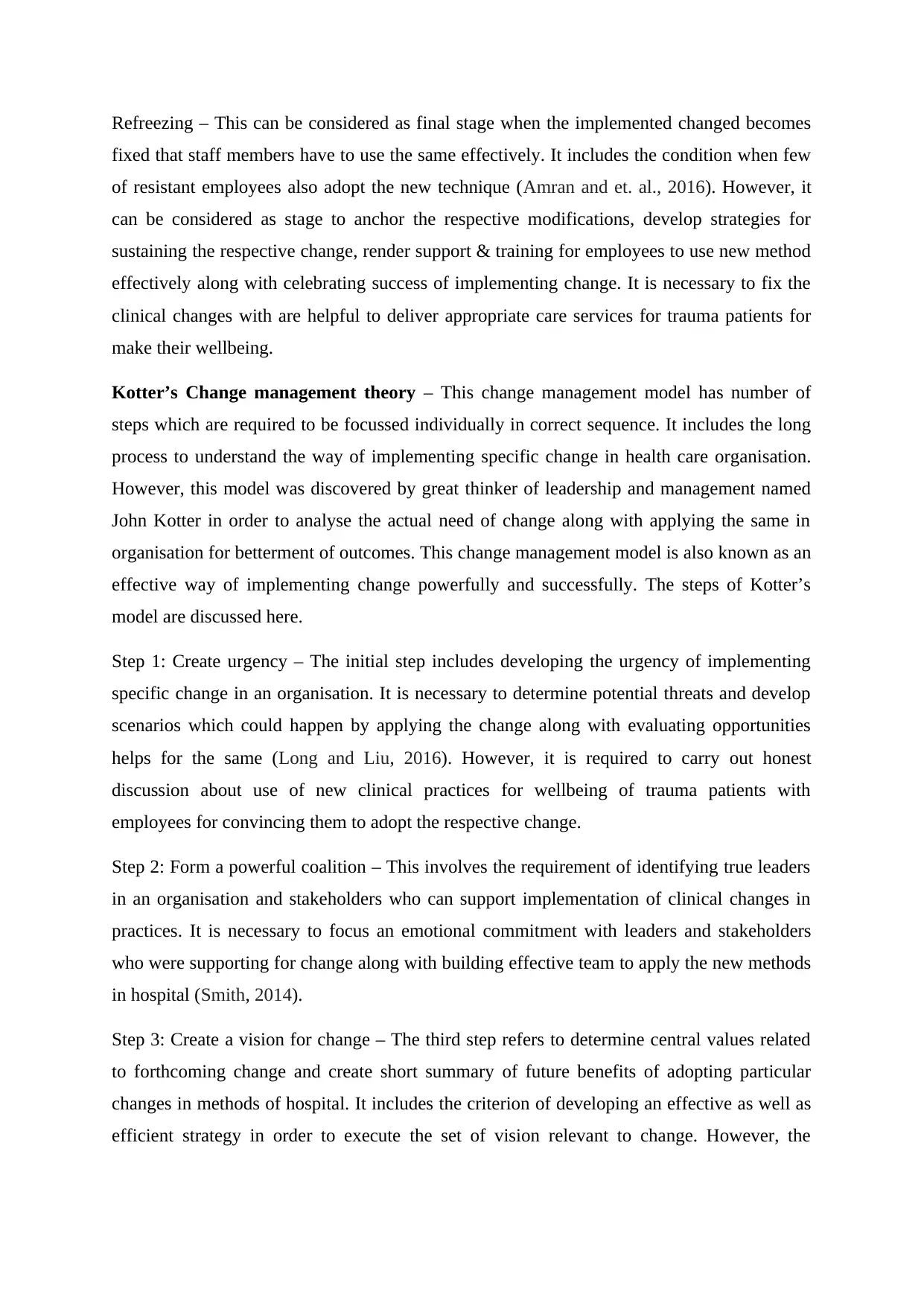
Refreezing – This can be considered as final stage when the implemented changed becomes
fixed that staff members have to use the same effectively. It includes the condition when few
of resistant employees also adopt the new technique (Amran and et. al., 2016). However, it
can be considered as stage to anchor the respective modifications, develop strategies for
sustaining the respective change, render support & training for employees to use new method
effectively along with celebrating success of implementing change. It is necessary to fix the
clinical changes with are helpful to deliver appropriate care services for trauma patients for
make their wellbeing.
Kotter’s Change management theory – This change management model has number of
steps which are required to be focussed individually in correct sequence. It includes the long
process to understand the way of implementing specific change in health care organisation.
However, this model was discovered by great thinker of leadership and management named
John Kotter in order to analyse the actual need of change along with applying the same in
organisation for betterment of outcomes. This change management model is also known as an
effective way of implementing change powerfully and successfully. The steps of Kotter’s
model are discussed here.
Step 1: Create urgency – The initial step includes developing the urgency of implementing
specific change in an organisation. It is necessary to determine potential threats and develop
scenarios which could happen by applying the change along with evaluating opportunities
helps for the same (Long and Liu, 2016). However, it is required to carry out honest
discussion about use of new clinical practices for wellbeing of trauma patients with
employees for convincing them to adopt the respective change.
Step 2: Form a powerful coalition – This involves the requirement of identifying true leaders
in an organisation and stakeholders who can support implementation of clinical changes in
practices. It is necessary to focus an emotional commitment with leaders and stakeholders
who were supporting for change along with building effective team to apply the new methods
in hospital (Smith, 2014).
Step 3: Create a vision for change – The third step refers to determine central values related
to forthcoming change and create short summary of future benefits of adopting particular
changes in methods of hospital. It includes the criterion of developing an effective as well as
efficient strategy in order to execute the set of vision relevant to change. However, the
fixed that staff members have to use the same effectively. It includes the condition when few
of resistant employees also adopt the new technique (Amran and et. al., 2016). However, it
can be considered as stage to anchor the respective modifications, develop strategies for
sustaining the respective change, render support & training for employees to use new method
effectively along with celebrating success of implementing change. It is necessary to fix the
clinical changes with are helpful to deliver appropriate care services for trauma patients for
make their wellbeing.
Kotter’s Change management theory – This change management model has number of
steps which are required to be focussed individually in correct sequence. It includes the long
process to understand the way of implementing specific change in health care organisation.
However, this model was discovered by great thinker of leadership and management named
John Kotter in order to analyse the actual need of change along with applying the same in
organisation for betterment of outcomes. This change management model is also known as an
effective way of implementing change powerfully and successfully. The steps of Kotter’s
model are discussed here.
Step 1: Create urgency – The initial step includes developing the urgency of implementing
specific change in an organisation. It is necessary to determine potential threats and develop
scenarios which could happen by applying the change along with evaluating opportunities
helps for the same (Long and Liu, 2016). However, it is required to carry out honest
discussion about use of new clinical practices for wellbeing of trauma patients with
employees for convincing them to adopt the respective change.
Step 2: Form a powerful coalition – This involves the requirement of identifying true leaders
in an organisation and stakeholders who can support implementation of clinical changes in
practices. It is necessary to focus an emotional commitment with leaders and stakeholders
who were supporting for change along with building effective team to apply the new methods
in hospital (Smith, 2014).
Step 3: Create a vision for change – The third step refers to determine central values related
to forthcoming change and create short summary of future benefits of adopting particular
changes in methods of hospital. It includes the criterion of developing an effective as well as
efficient strategy in order to execute the set of vision relevant to change. However, the
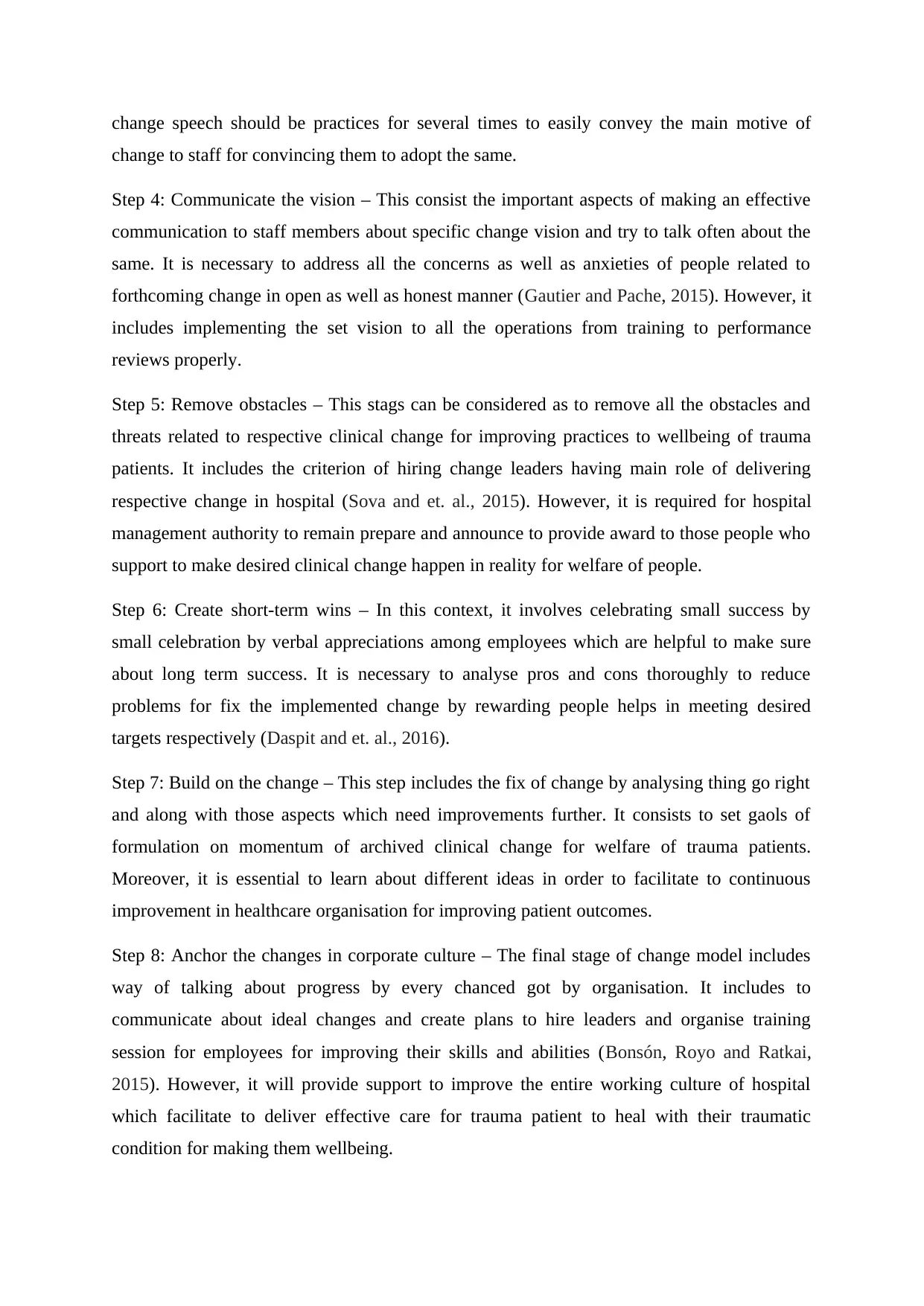
change speech should be practices for several times to easily convey the main motive of
change to staff for convincing them to adopt the same.
Step 4: Communicate the vision – This consist the important aspects of making an effective
communication to staff members about specific change vision and try to talk often about the
same. It is necessary to address all the concerns as well as anxieties of people related to
forthcoming change in open as well as honest manner (Gautier and Pache, 2015). However, it
includes implementing the set vision to all the operations from training to performance
reviews properly.
Step 5: Remove obstacles – This stags can be considered as to remove all the obstacles and
threats related to respective clinical change for improving practices to wellbeing of trauma
patients. It includes the criterion of hiring change leaders having main role of delivering
respective change in hospital (Sova and et. al., 2015). However, it is required for hospital
management authority to remain prepare and announce to provide award to those people who
support to make desired clinical change happen in reality for welfare of people.
Step 6: Create short-term wins – In this context, it involves celebrating small success by
small celebration by verbal appreciations among employees which are helpful to make sure
about long term success. It is necessary to analyse pros and cons thoroughly to reduce
problems for fix the implemented change by rewarding people helps in meeting desired
targets respectively (Daspit and et. al., 2016).
Step 7: Build on the change – This step includes the fix of change by analysing thing go right
and along with those aspects which need improvements further. It consists to set gaols of
formulation on momentum of archived clinical change for welfare of trauma patients.
Moreover, it is essential to learn about different ideas in order to facilitate to continuous
improvement in healthcare organisation for improving patient outcomes.
Step 8: Anchor the changes in corporate culture – The final stage of change model includes
way of talking about progress by every chanced got by organisation. It includes to
communicate about ideal changes and create plans to hire leaders and organise training
session for employees for improving their skills and abilities (Bonsón, Royo and Ratkai,
2015). However, it will provide support to improve the entire working culture of hospital
which facilitate to deliver effective care for trauma patient to heal with their traumatic
condition for making them wellbeing.
change to staff for convincing them to adopt the same.
Step 4: Communicate the vision – This consist the important aspects of making an effective
communication to staff members about specific change vision and try to talk often about the
same. It is necessary to address all the concerns as well as anxieties of people related to
forthcoming change in open as well as honest manner (Gautier and Pache, 2015). However, it
includes implementing the set vision to all the operations from training to performance
reviews properly.
Step 5: Remove obstacles – This stags can be considered as to remove all the obstacles and
threats related to respective clinical change for improving practices to wellbeing of trauma
patients. It includes the criterion of hiring change leaders having main role of delivering
respective change in hospital (Sova and et. al., 2015). However, it is required for hospital
management authority to remain prepare and announce to provide award to those people who
support to make desired clinical change happen in reality for welfare of people.
Step 6: Create short-term wins – In this context, it involves celebrating small success by
small celebration by verbal appreciations among employees which are helpful to make sure
about long term success. It is necessary to analyse pros and cons thoroughly to reduce
problems for fix the implemented change by rewarding people helps in meeting desired
targets respectively (Daspit and et. al., 2016).
Step 7: Build on the change – This step includes the fix of change by analysing thing go right
and along with those aspects which need improvements further. It consists to set gaols of
formulation on momentum of archived clinical change for welfare of trauma patients.
Moreover, it is essential to learn about different ideas in order to facilitate to continuous
improvement in healthcare organisation for improving patient outcomes.
Step 8: Anchor the changes in corporate culture – The final stage of change model includes
way of talking about progress by every chanced got by organisation. It includes to
communicate about ideal changes and create plans to hire leaders and organise training
session for employees for improving their skills and abilities (Bonsón, Royo and Ratkai,
2015). However, it will provide support to improve the entire working culture of hospital
which facilitate to deliver effective care for trauma patient to heal with their traumatic
condition for making them wellbeing.
⊘ This is a preview!⊘
Do you want full access?
Subscribe today to unlock all pages.

Trusted by 1+ million students worldwide
1 out of 21
Related Documents
Your All-in-One AI-Powered Toolkit for Academic Success.
+13062052269
info@desklib.com
Available 24*7 on WhatsApp / Email
![[object Object]](/_next/static/media/star-bottom.7253800d.svg)
Unlock your academic potential
Copyright © 2020–2025 A2Z Services. All Rights Reserved. Developed and managed by ZUCOL.





